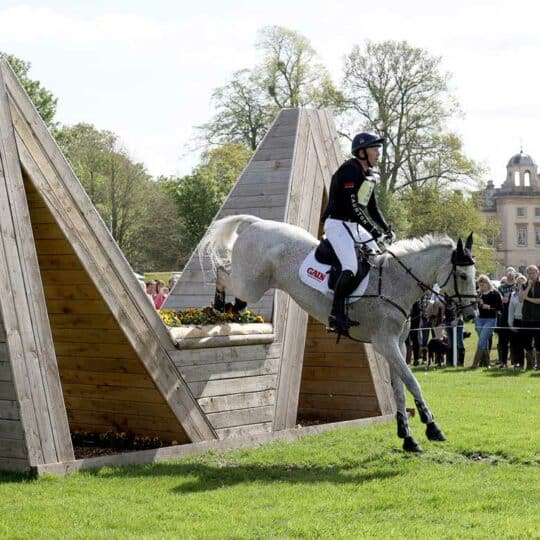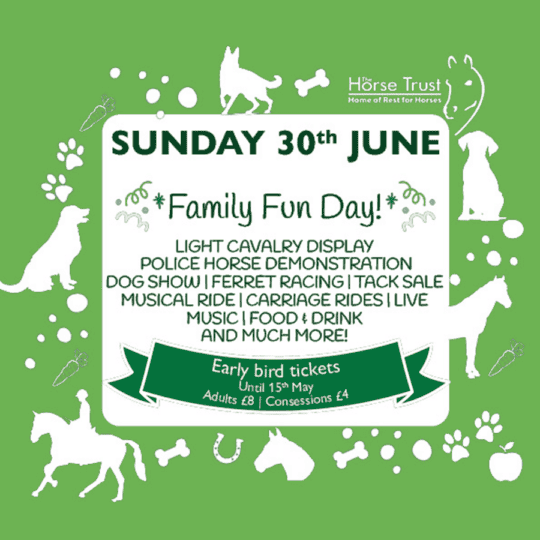Considering going barefoot, but mystified by conflicting advice? Read on for our comprehensive guide to embracing the shoeless lifestyle
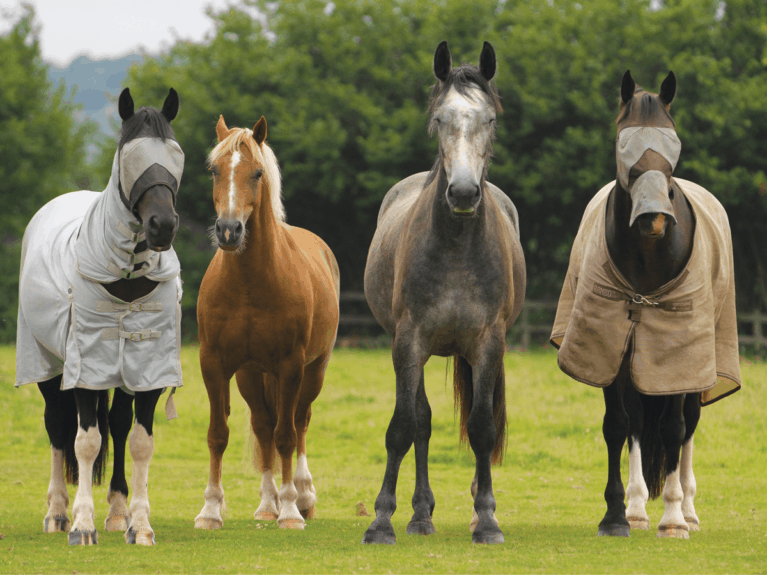
Without four sound, healthy feet to stand on, your horse can’t carry out the work you want him to do. Advances in horse care mean there are more options than ever before when it comes to shoeing – from traditional steel and lightweight aluminium to glue-on plastic and composite varieties. But is there a benefit to keeping it simple and doing away with shoes entirely?
The benefits of going barefoot vary from horse to horse, but can include improved circulation to his feet, enhanced traction, a better way of going and stronger, healthier hoof growth. If you’ve been considering the barefoot route, there are several things to think about.
Making it count
While a barefoot trim is cheaper than a set of shoes, there are associated costs that are likely to crop up as your horse transitions, such as buying hoof boots to help while his feet are still sensitive. Some barefoot horses need trimming more regularly than a shod horse would and, as such, finances shouldn’t be your primary motivator when making the decision to remove your horse’s shoes. It’s important to base your decision on what will make him happy and comfortable in his work. Speak to your farrier, who knows your horse’s hooves and growing patterns, for advice on what your horse will need to help him succeed. Your vet will also be able to help you make an informed decision.
The ideal candidate
Certain horses are better suited to being barefoot than others. If your horse has solid, healthy hoof walls and thick soles, he’s likely to find it easier to go without shoes than one with less healthy feet. Think carefully about removing his shoes if he…
- struggles with serious foot-soreness
- competes in a discipline in which he needs extra grip in the form of studs
- relies on remedial or corrective shoeing to overcome the effects of a conformational defect
- has suffered from changes to his coffin bone and wears pads to compensate
However, every horse’s needs are unique, and many with problematic hooves have successfully overcome issues with growth, sensitivity and hardiness over a period of time with the careful management.
Finding a farrier
Trimming alone isn’t regulated under the Farriers Registration Act, which means that anyone can call themselves a barefoot practitioner or trimmer, regardless of skill level. There are a number of barefoot hoofcare organisations promoting their members, but it’s important to check that whoever you choose has a recognised qualification and appropriate insurance. Visit farrier-reg.gov.uk to search for qualified farriers in your area who can help you to get your horse’s feet on the right track.
There’s a big difference between a trim suitable for a barefoot horse at rest or to prepare the hoof for a shoe and a barefoot trim for a working horse, which takes into account individual hoof shape and shock absorption, the surface the horse will be ridden on and the nature of the work he does. Because of this, you’ll need a farrier who specialises in preparing and reshaping the hoof for barefoot work.
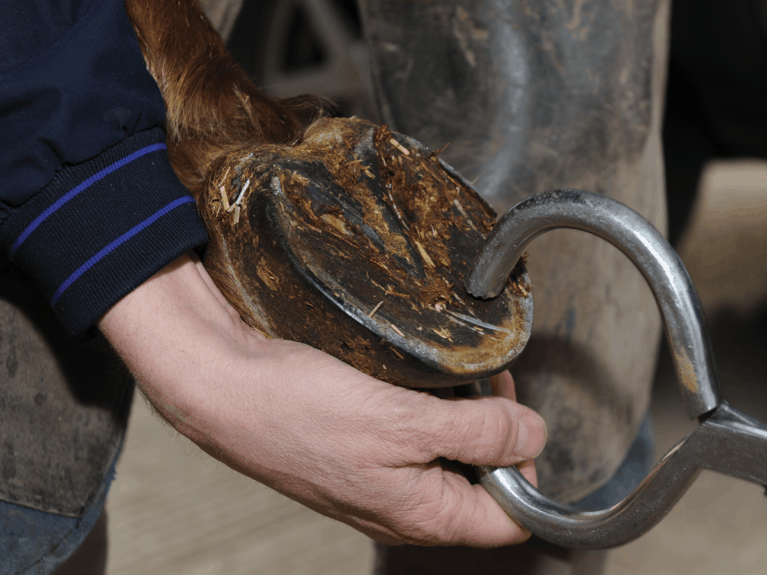
All change
Adjusting from shod to barefoot isn’t as simple as removing your horse’s shoes and hoping for the best. To avoid foot soreness, plan his transition carefully. His hooves are likely to be slightly more tender in the early stages and you should allow for anywhere up to three months for them to get to the point where your farrier can begin to reshape them, rather than just trimming them. The full transition process can take up to a year.
During the transition, your horse’s hoof wall should start to strengthen and his sole start to thicken in order to cope with direct contact with the ground. Your farrier will test the thickness of his sole with hoof testers – if it’s very thin, keep him on a soft surface, but spend time gently working on firmer terrain each day to encourage thickening without making him sore. A naturally thicker sole can cope with more varied surfaces and more exposure to firm going earlier on.
Consider his workload when transitioning – you’re likely to find that he gets sore if you continue to ride him as you did before removing his shoes. Treat his transition period like a fitness regime – you have to find a comfortable level for him to work at, then slowly build it up.
An easy start
If your horse is used to being unshod – for example, if he’s a youngster you’re going to begin backing or if he’s had a length of time off work without shoes – his transition period will be slightly different, as his soles and hoof walls will already be used to coping with the barefoot lifestyle and, as such, won’t need as careful a transition process. However, as your horse starts or restarts his working life, his hooves will have to bear more weight, cover a wider variety of surfaces and compensate in a different way than he is used to, so keep an eye on their condition and maintain a regular trimming schedule with your farrier. If your horse starts to show any signs of problems or weakness in his hooves, you can rethink whether he needs to be shod.
TOP TIP
Ask your farrier whether your horse may benefit from the regular application of hoof grease or balm, but be aware that you’re only likely to see benefits if you apply the product regularly.
It’s all in the angles
When trimming your barefoot horse, your farrier will keep in mind several factors, including breakover, flare and hoof shape. Most barefoot horses are trimmed with a bevelled edge along their toe, encouraging the hoof to land heel first and making the rear two-thirds of the foot the primary weight-bearing area. This reduces concussion and adjusts the breakover, changing the point at which the hoof leaves the floor during movement.
Hoof flare is a sign of abnormal growth and wear, and can range from obvious to very subtle. Your farrier will take hoof flare into account when trimming your horse, and may add a roll or bevel to decrease the degree of flare over time.
Your horse’s hooves will change shape and expand as he adapts to being barefoot, so your farrier will, in turn, adapt the way he trims them to encourage correct, healthy growth, particularly if your horse started out with insufficient growth in particular area, such as low heels.

Feed for feet
When feeding a barefoot horse, pay extra attention to the nutrients needed for optimum hoof strength and quality. It’s also important to remember that too much sugar in the diet can cause inflammation in the laminae, leading to poor hoof quality and tenderness.
- Feed good-quality forage Soaking hay before feeding helps to cut the sugar content. Late-cut, stalky forage also contains less sugar.
- Limit rich grass intake Grass is high in sugar content so, if possible, turn your horse out in a paddock or field with moderate grazing rather than thick, lush grass and provide hay to make up his forage ration.
- Opt for unmolassed chaff It’s a good source of nutrients and the analysis label helps you keep track of what your horse needs.
- Add micronised linseed This provides omega-3, an essential fatty acid that can help to improve hoof growth and quality.
- Consider a supplement Certain vitamins and minerals are missing from a largely forage-based diet, so a supplement or balancer can be used to add missing nutrients. Minerals to look out for include copper, zinc, selenium and vitamin B1.
- Give biotin a go Good-quality forage often provides sufficient biotin levels, but if his diet is lacking in it provide a biotin supplement. Biotin is a B vitamin that may help to promote the healthy growth of your horse’s hoof wall.
Keep him moving
Wild horses travel miles each day in search of food and water. This constant movement benefits hoof health, as it increases circulation within the hoof helping to flush out toxins and promote strong, healthy hoof growth. Giving your horse plenty of turnout will help simulate this, but be careful about the surface you turn him out on – hard or rocky ground could cause adverse wear or bruising, particularly while he’s still transitioning.
Give him the boot
If your horse struggles with roadwork or uneven ground without shoes, consider fitting hoof boots when he’s ridden.
There’s a huge variety of boots available and no one-size-fits-all solution. To make an informed choice, speak to somebody experienced in using them, or a hoof boot retailer who can advise you which style or shape might suit your horse and discipline. Some retailers will also loan you fitting kits so you can select the correct size or allow you to hire the boots to make sure they’re right for your horse.
To ensure a perfect fit, it’s best to take your horse’s hoof measurements. You’ll need the following for each hoof, as they might not all be the same size…
width – measure the underside of his hoof at its widest point
length – measure from the centre of his toe to the back of his hoof, level with the heel bulb
If your horse is a bit of a fidget, put a piece of paper under his hoof on a flat, level surface and draw round it, then use a ruler to measure the outline. Keep in mind that some boots can be bought individually while others are only sold in pairs.
TOP TIPS
- Even if your horse is coping well, consider hoof boots if riding on the road or in a sand school is a regular part of your routine. Tarmac and sand are very abrasive to the hoof and will cause his hoof wall to wear away more quickly than riding on grass or rubber.
- Hoof boots aren’t allowed by all discipline governing bodies, so if you want to compete in them, check your chosen organisation’s rulebook first.
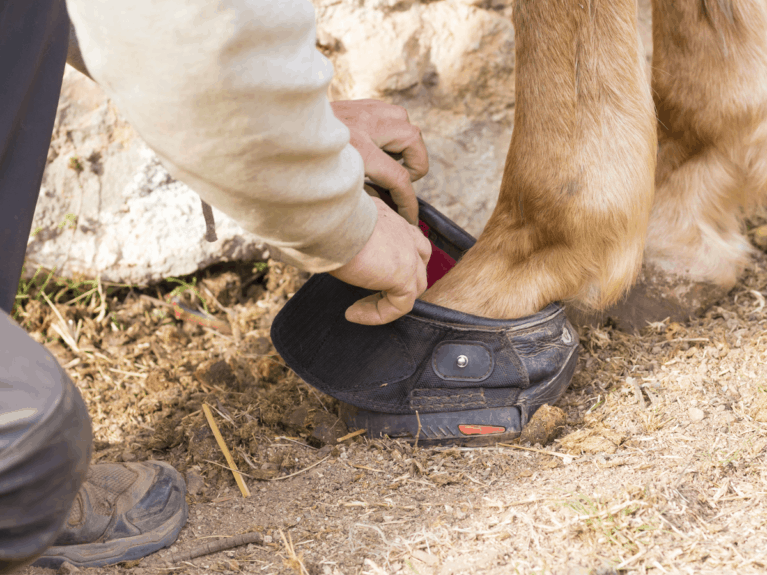
Listen to your horse
There are benefits and arguments both for shoeing and going barefoot, but the most important thing is to work closely with your farrier and vet to come up with a solution that suits your horse. There’s no right or wrong answer – the best thing to do is tailor your hoofcare plan to his individual needs.
Case study – the barefoot convert
Jessica and Sunny
Sunny was fully shod when I bought him, but after two months off I decided to try barefoot, as he’d been losing shoes on a weekly basis and, with them, large chunks of hoof wall.
He experienced some minor foot soreness initially, so I avoided riding over gravel or doing too much trotting on the roads, but within about three months he’d adjusted to his new lifestyle and was able to hack on the roads and school in the field comfortably. More than a year later, he’s checked by my farrier regularly, but has doubled the length of time between trims and no longer suffers from knocks and overreach injuries when playing in the field.
Case study – better in shoes
April and Casper
When I was told Casper needed three months’ rest after surgery, it made sense to remove his shoes. His feet held up well and when he came back into work my farrier and I agreed he should stay barefoot.
The biggest surprise was how often his feet needed trimming – much more so than he’d needed shoeing. And it wasn’t to remove large amounts of hoof, but to deal with chips, flakes and splits. Luckily my farrier was understanding when I panicked that a piece of hoof was suddenly missing after a ride. This normal wear and tear took me time to get used to, but didn’t affect Casper’s ability to work.
Being barefoot worked really well – Casper moved brilliantly and was happy on different surfaces, although I was careful on gravelly tracks. However, as his workload increased he wasn’t growing enough hoof to cope with overnight turnout, roadwork and schooling on sand. After much soul-searching, I made the decision to have his shoes put back on nine months after they’d been removed.
I learnt a lot from the experience and am definitely much more open to the idea of trying barefoot again.
Case study – helped by hoof boots
Charlotte and Sam
After a friend of mine transitioned her horse to barefoot and found it helped his feet, I decided to give it a try with my Thoroughbred, Sam.
Knowing his feet weren’t the best, I expected Sam to be a bit sore initially and for longer than my friend’s cob, but he was uncomfortable for longer than I anticipated. Six months later he was still struggling and he’d had numerous foot abscesses, especially when the ground was wet and his feet were soft. I was advised to stick with it, but after one ride when he felt as uncomfortable as ever, I knew I had to do something. There was no denying the changes in Sam’s hoof condition – despite his discomfort, they looked healthier and stronger than ever, so I was reluctant to go back to shoes.
I decided to try hoof boots for ridden work, which has made the world of difference. I’ve tried the odd ride without them see if his feet have hardened up enough to cope, but he just became sore again. The boots have enabled us to enjoy all the benefits of going barefoot without putting Sam through any more discomfort. Despite the difficult journey, I’m really glad I did it and I’d advise anyone to give it a try.









